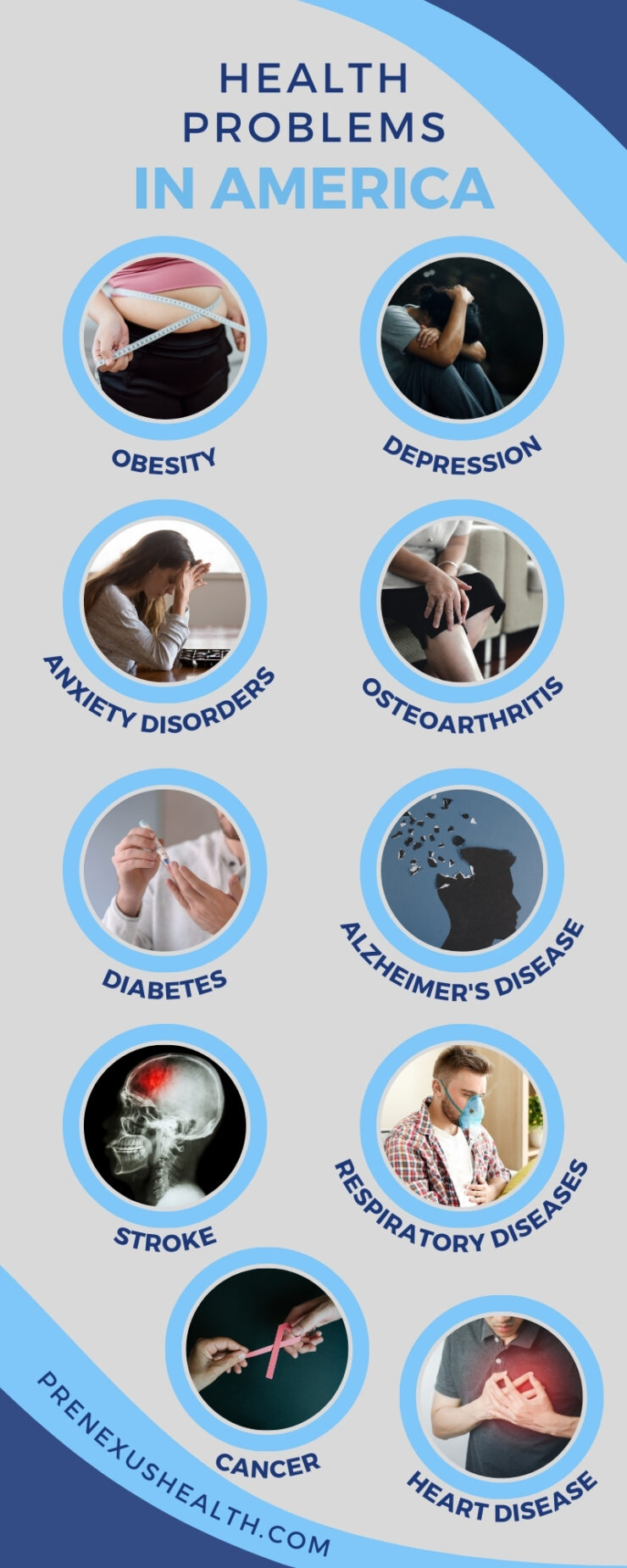The United States is one of the unhealthiest developed nations in the world despite spending $4.5 trillion on healthcare in 2022, which translates to $13,493 per person.
Still, approximately 45% of all Americans, which is around 133 million individuals, suffer from at least one chronic disease. They are primarily driven by poor diet, lack of exercise, smoking, and other unhealthy behaviors.
Here are 10 of the most common health problems facing Americans today:
10. Obesity
Over 40% of American adults are obese, putting them at higher risk for heart disease, stroke, high blood pressure, diabetes, cancers, and other problems. Obesity results from poor diet, lack of exercise, genetics, and other complex factors.
Weight loss medications and bariatric surgery may also be treatment options for some individuals.
9. Depression
Depression is characterized by persistent sadness, hopelessness, sleep issues, anger, and loss of interest in everyday activities.
It affects 21 million Americans, is more prevalent in women, and can lead to suicide.
While therapy and antidepressants help many people, lifestyle interventions like exercise, healthy eating, mindfulness, and improving social connections also support treatment and can help prevent recurrence.
8. Anxiety Disorders
Anxiety disorders like generalized anxiety, social anxiety, phobias, and panic disorders affect over 19 million American adults.
These manifest as:
- excessive fear or worry
- restlessness
- fatigue
- irritability
- muscle tension
- sleep disturbance.
Therapy and medications like SSRIs, SNRIs, and benzodiazepines can help manage symptoms. Also, lifestyle changes like exercising, meditating, limiting alcohol, and improving sleep habits also support treatment.
7. Osteoarthritis
Osteoarthritis is the most common form of arthritis, affecting over 30 million adults. It results from wear and tear on joint cartilage and underlying bone. Symptoms include pain, stiffness, swelling, and decreased range of motion. Knees, hips, and lower back are most impacted. Excess weight, joint injuries, and intense physical activity can increase risk.
This can help manage symptoms:
- losing weight
- avoiding injury
- balancing rest
- exercise
- using proper form
- taking over-the-counter pain relievers
6. Diabetes
Diabetes cases have tripled over the past 20 years, affecting over 30 million Americans. 90-95% of cases are Type 2 diabetes, linked to obesity, physical inactivity, and poor diet. It increases the risk of heart disease, stroke, kidney disease, blindness, and limb amputations. Type 1 diabetes is an autoimmune disorder arising in childhood.
Controlling carbohydrate intake, maintaining a healthy weight, exercising regularly, and taking medication as directed can help manage diabetes. Routine screenings allow for early diagnosis and treatment. Also, prescription discounts like BuzzRX can help alleviate the financial burden of diabetes medications and supplies, making management more accessible for those in need.
5. Alzheimer’s Disease
Alzheimer’s is the most common form of dementia, afflicting over 5 million Americans.
| Consequence/Condition | Cause/Risk Factor |
|---|---|
| Memory Loss | Growing older, genetic factors, head trauma |
| Confusion | Family history, high blood pressure, heart disease |
| Impaired Judgment | Head trauma, growing older, genetic factors |
| Loss of Independence | High blood pressure, heart disease, family history |
Staying physically and mentally active, controlling blood pressure, avoiding head injuries, and keeping socially engaged may help lower Alzheimer’s risk. There is no cure, but early diagnosis allows for better planning and medication management.
4. Stroke
Stroke is the fifth leading cause of death, killing over 140,000 people annually. Ischemic strokes caused by blood clots are most common. Hemorrhagic strokes caused by bleeding in the brain are less frequent but more often fatal.
Major risk factors for stroke include:
- high blood pressure
- high cholesterol
- smoking
- obesity
- physical inactivity
- unhealthy diet
- diabetes
80% of strokes are preventable. Preventive measures involve controlling blood pressure and cholesterol levels, quitting smoking, exercising regularly, limiting alcohol, and eating a low-sodium, high-fiber diet.
3. Respiratory Diseases
Respiratory illness is the third leading cause of death in America. Chronic lower respiratory diseases like COPD, chronic bronchitis, emphysema, and asthma afflict millions of Americans.
Cigarette smoking is by far the primary risk factor, accounting for over 85% of COPD deaths. But, air pollution, indoor and outdoor allergens, genetic predisposition, respiratory infections, and occupational chemical or particulate hazards also contribute to chronic lung disease.
Here is what can help protect lung health and prevent exacerbations of respiratory illness:
- avoiding tobacco smoke exposure
- getting annual flu and pneumonia vaccinations
- minimizing exposure to industrial irritants and known allergens
- wearing masks in poor air quality
- managing conditions like asthma and allergies with regular medical care
2. Cancer
Cancer is the second leading cause of mortality, responsible for nearly 600,000 deaths annually. The most common cancers in the U.S. are:
- breast
- lung
- prostate
- colorectal cancers.
Yet, incidence and mortality rates vary greatly by cancer type.
Also, obesity rates have more than doubled in adults since the 1970s, so obesity-related cancers like uterine, pancreatic, kidney, and liver cancer are rising.
What can help?
Well, quitting smoking, maintaining a healthy weight, protecting skin from excessive sun exposure, getting recommended cancer screenings, and undergoing HPV vaccination can all help prevent cancer.
Public health initiatives aimed at encouraging healthy lifestyles and increased screening participation are key to further reducing the cancer burden.
1. Heart Disease
Heart disease remains the leading cause of death in the U.S., accounting for 1 in 4 deaths. Coronary artery disease, heart attacks, congestive heart failure, and other cardiovascular diseases kill over 600,000 Americans every year. Major risk factors include:
- high blood pressure
- high LDL cholesterol
- smoking
- obesity
- physical inactivity
- poor diet
- diabetes
Many of these risk factors are modifiable through lifestyle changes.
These strategies can prevent up to 80% of heart disease case:
| Prevention Strategy | Details |
|---|---|
| Medication and Dietary Changes | Helps in keeping blood pressure and cholesterol levels in check. |
| Avoid Smoking and Secondhand Smoke | Essential for heart health and reducing the risk of heart disease. |
| Regular Cardiovascular Exercise | Increases heart health and overall well-being. |
| Nutritious, Low-Sodium Diet | A diet rich in fruits, vegetables, and whole grains helps prevent heart disease. |
Also, monitoring health metrics through regular checkups allows for early intervention when risk factors become elevated.
Conclusion
The prevalence of preventable chronic diseases highlights the importance of lifestyle choices for long-term health.
Quitting smoking, limiting alcohol, reducing stress, improving diet, staying active, and getting health screenings are all small steps anyone can take to live a healthier life. With some changes to daily habits and access to quality preventive healthcare, Americans can work towards a future with lower rates of chronic illness.
Hey there, my name is Martha Robinson and I’m an experienced medical content writer. Initially, I wanted to become a pediatrician, but at one point I decided that writing is my passion. I’ve authored numerous pieces on various subjects, but my expertise lies in skin health









